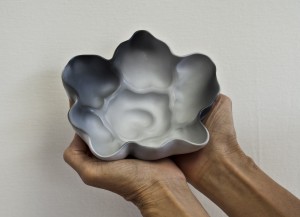Jump Your Tracks
It happened back in the good old days of homesteading Quietude Pottery in Alaska that I dealt with the fixed rails of bureaucracy. After cutting the lines, building the cabin and living on the land for three years, a surveyor was called. He measured, calculated and documented the reality I called home. When at last his work was done and the map arrived, I noticed that his plotting was flawed. He had oriented the rectangular, 17.5 acres of my homestead east to west, not north to south. I realized that at some point down the line this would become a problem. So, I went into the land office to explain the situation. I was assured numerous times that the surveyors map was not and could not possibly be wrong. This paper was, for them, reality. There for, in their minds, I must be wrong. Over and over I explained the situation: the reality of the land and my intimate relationship with it. Over and over she insisted that the reality of the paper overrode my unfounded belief in my own personal experience on the land. At some point she must have jumped her tracks: because the surveyor would indeed be called back. As for his findings, suffice it to say, that the reality of the land surely does trump the so-called reality of their paper world.
This week I have been accused of using a term that does not exist. The term “pit finished ceramics”, I am told, does not exist because it has no “scholarly credibility”. It has never once been published, anywhere, therefore, from an academic point of view it does not exist. I have never once been accused of being an academic, ever, therefor I am not. I am a dyslexic poet. The term “pit finished ceramics” I assure you exists, because I myself coined and published it on my humble little blog, just last week!
The river does not follow,
the train upon its tracks.
It is the tracks,
that follow the stream.
Only the river is free,
to change it’s course.
Last week in the infinite wisdom of the dream time, I grabbed hold of the mane of an unbridled horse, flung myself upon his wild, naked back and rode. I could see the river flowing free and the tracks of the train beside it heading south. I ride upon the back of an unbridled horse: not even the banks of the river shall contain me, for I am free!
Elohim, Ants and Arugula
I just must take a moment here to give thanks for the simple and lovely fact that the greenhouse ants do not seem to care for spinach. These are the regular type of large red ants. They are not the really huge headed reds that Moon and I see out walking in the desert. I love them all. But it is a special pleasure to watch the greenhouse ants harvest the kale and carry it home. These days, now that we are hitting the low 90’s, it is dry by the time they get it home. Super organic homegrown kale makes for healthy happy ants. But I must admit that I was a little miffed at how hard they hit the arugula seed pods! Perhaps they have plans to do a little farming of their own! I am every bit as fond of the incredible intelligence of the arugula seed as I am my precious friends the ants. The arugula seed knows how to wait. They will sit all summer out, right there on the scorching earth, rain or no and wait. Perhaps a really late summer /fall or very early winter rain will come! And then there will be an arugula wide burst of creative energy. We can learn a lot from the patience and utter brilliance of the ant and the arugula seed.
In love, under the full Moon.


![IMG_1455[1]](https://www.firebirdceremonies.com/wp-content/uploads/2014/04/IMG_14551-300x225.jpg)
![IMG_1451[1]](https://www.firebirdceremonies.com/wp-content/uploads/2014/04/IMG_14511-300x225.jpg)
 RSS
RSS